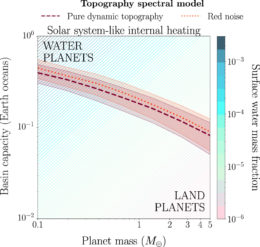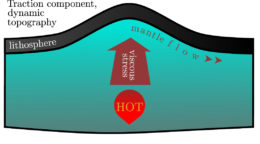What determines whether a planet is dotted with continents or has oceans as far as the eye can see? Astronomers turn to models to understand how bulk planetary properties affect surface oceans on rocky, water-rich exoplanets.
Land Ho?
If a planet’s surface is perfectly smooth, water will wash across it to form a global ocean of constant depth. If instead the surface is roughened with mountains and valleys, the planet can host more water before its surface is fully covered. But what factors control whether a planet’s surface is flat and featureless or textured with topography, and thus how much water it can hold before becoming an ocean world?
A new article led by Claire Marie Guimond (University of Cambridge, UK) explores how the distribution of dry land and oceans on exoplanetary surfaces might be impacted by dynamic topography. Dynamic topography arises when a planet’s core is hotter than its surface, causing the material in between — the mantle — to undergo a slow churning on million-year timescales. This convection applies pressure to the planet’s crust, inducing upwellings and depressions up to a kilometer in size. Unlike plate tectonics, which is largely responsible for the diversity of topography on Earth but doesn’t occur on all planets, dynamic topography is expected to be a nearly universal feature of rocky planets.
Plots of the change in a planet’s root-mean-square topography as a function of four potentially observable quantities. The quantities held fixed in each set of simulations are listed in the upper right corner of each panel. Click to enlarge. [Adapted from Guimond et al. 2022]
Modeling Mantle Convection
Guimond and collaborators first used complex two-dimensional numerical models to understand how a planet’s dynamic topography scales with factors like the thickness and composition of the mantle. These trends formed the backbone of less computationally expensive models, with which the team explored how a planet’s mass, age, radioactive element abundance, and core mass impact the size of its surface features.
The team found that the typical height of surface features increases with increasing planetary age and core mass and decreases with increasing planetary mass and radioactive element abundance. Planetary mass and radioactive element abundance had the strongest effect, suggesting that these factors are key to predicting a planet’s topography. The modeled surface features tended to be in the hundred-meter range, though the most massive planets had subtle hills and valleys of only a few tens of meters.
Weighty Water Worlds and Low-Mass Land Planets

Basin capacity as a function of planet mass. If a given surface water mass fraction exceeds the basin capacity, the planet will have a global ocean (labeled “water planets”). If the water mass fraction is less than the basin capacity, the planet will have dry land (labeled “land planets”). [Adapted from Guimond et al. 2022]
Aside from dynamic topography, planets are likely to have many other surface processes at play, like impacts from asteroids and comets, volcanism, and plate tectonics, all of which might boost the amount of high-and-dry land available on a planet. The authors hope that further modeling as well as observations of exoplanets and Earth itself can increase our ability to predict the surface conditions of distant planets.
Citation
“Blue Marble, Stagnant Lid: Could Dynamic Topography Avert a Waterworld?,” Claire Marie Guimond et al 2022 Planet. Sci. J. 3 66. doi:10.3847/PSJ/ac562e

